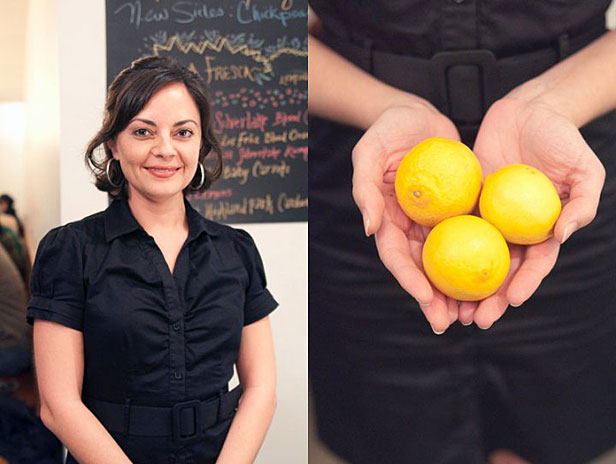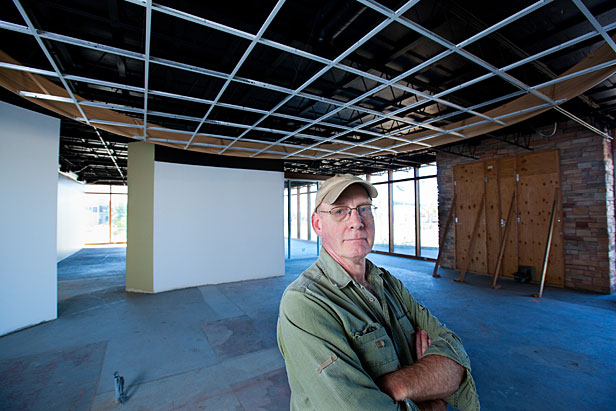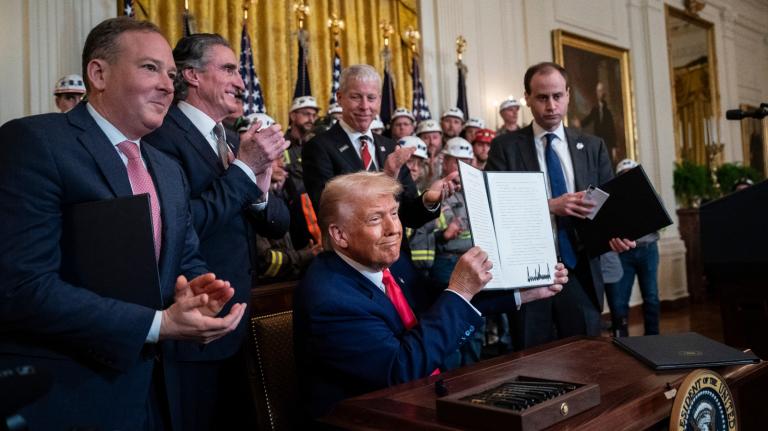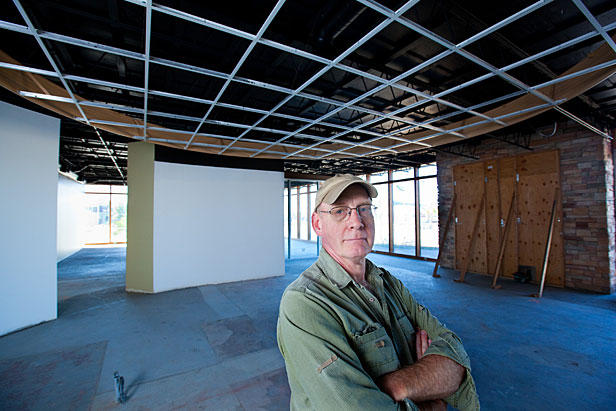 Seeing green: Gene Fredericks of Big Green Boxes imagines fish ponds, waterfalls, and racks and racks of edible greens and herbs in defunct spaces like this one. (Bart Nagel Photography)
Seeing green: Gene Fredericks of Big Green Boxes imagines fish ponds, waterfalls, and racks and racks of edible greens and herbs in defunct spaces like this one. (Bart Nagel Photography)
In our New Agtivist interviews, we talk to people who are working to change this country’s f’ed-up food system in inspiring ways.
They’re the bane of urban and suburban areas alike: the vacant, boarded-up K-Marts and Home Depot Expos, squatting like concrete cowpies amidst a landscape of weedy parking lots. But where most people see blight and a waste of space, San Francisco Bay Area entrepreneur Gene Fredericks sees opportunity: to grow food. Lots of food.
Neither a farmer nor a foodie, Fredericks is a technology veteran who’s designed several large, complex network and software systems, working with Apple, Getty, Google, Kaiser, and others; he previously founded Edison-West and ran it for 15 years. And now he’s trying to raise money to launch his latest venture, Big Green Boxes, which he thinks will bring a new, high-tech, sustainable approach to Feeding the City.
Q. What is Big Green Boxes, exactly?
A. It’s a new business that will transform unused warehouse space into year-round indoor growing centers. We’ll use hydroponics and aquaponics, along with advanced low-energy lighting techniques and vertical growing methods, to produce the very freshest leafy greens for local consumption regardless of climate.
Our goal is to be a sustainable and profitable business that provides tasty, preservative- and pesticide-free fresh food, grown in the community for the community; that creates new jobs; revives some neglected real estate; and offers some pretty interesting educational exposure to green technologies.
Q. How’d you get the idea?
A. Living in the East Bay [across from San Francisco], I saw so many empty vacant warehouses and wondered what could be done with them and for the community at large, especially in light of the recent economic downturn. The idea of growing food came to me. I spent a few months investigating the technology, economic feasibility, and societal desirability of doing indoor growing. I got such an amazingly positive response on all fronts that I decided to put together the team that could pull it off.
I also knew certain high-priced crops were already being grown indoors, and now, having met with food brokers and local markets, and developing our business plan, I think BGB can profitably sell the freshest locally grown produce at highly competitive prices year round.
Q. You’re kind of a techno geek with no farming background. What makes you qualified to start BGB?
A. Well, I look at Big Green Boxes as a high-tech business. But it’s a very different one from large-scale farming, which has turned into a high-tech business by growing produce in huge volumes far from the end consumer, and which uses technology to modify, preserve, package, transport, and store their produce. BGB could change that. By using a combination of very new and very old technologies, local communities can grow their own fresh produce year round.
Q. Fans of the show Weeds know that hydroponics is growing plants in water instead of soil, and that certain cash crops do very well in it. But what’s “aquaponics,” exactly?
A. Aquaponics is the combination of hydroponics and aquaculture, which is the raising of fish. The fish provide the rich nutrients to grow the plants, and the plants clean the water for the fish. It’s a closed-loop system that uses 90 percent less water than growing the same greens in soil and can yield 10 times more crops than land-based growing systems.
Aquaponics is centuries old. It was used by ancient cultures like the Aztecs and the Egyptians. It just seems new since most people are not familiar with it yet.
And oh — the funny thing about pot is, there’s zero reason to be growing it indoors other than the legal one. You don’t pick it and eat it fresh; it needs to be cured. It would be an ideal crop for the Central Valley.
Q. By “rich nutrients,” you mean fish poop?
A. Yes. When people seem squeamish about that, I remind them that land-based systems rely on manure from animals, worms and bugs. The water we use to irrigate soil crops once had fish swimming in it, too! One way or another, things are grown in — well, shit. We don’t think much about that, but that’s how things grow.
Q. OK, so walk me through a Big Green Box.
A. We’ll take a freestanding vacant retail space or warehouse space, around 30,000 square feet, climate-control it, and set up some ponds and tanks for the fish — pleasant ones you can see, not unlike the goldfish and Koi ponds in an office-building lobby or a park. There’ll also be small waterfalls, which in addition to looking nice help aerate the water. The water from the ponds and tanks will go into settling tanks as well as a few bio-filtering tanks that will make sure no elements that might harm the plants or the fish get through. The nutrient-rich water then flows into the growing areas. The plants and growing area then filter the water, which gets recycled back to the fish.
There are few kinds of hydroponic growing methods, and we’ll use several, depending on the kind of plant. Some plants do better in one than another. We’ll also grow both horizontally and vertically to increase the planting surface area.
Q. And you’ll grow what, exactly?
A. Fresh greens and herbs, particularly ones that command a premium and that people want all year round. Take basil, for example; it’s a seasonal crop with a short shelf life. Trader Joe’s is selling organic basil from Mexico right now at $2.79 for 4 ounces. That’s $11.16 per pound! And it’s coming from Mexico. We’ll also grow fancy red and green lettuces, arugula, radicchio, sprouts, baby and micro greens, and several kinds of herbs, which sell for even higher prices. We’ll change the crops based on time of year, local tastes, and customer preferences.
We’ll sell our daily fresh produce to pre-standing orders from local fresh-produce brokers, who’ll in turn sell to restaurants, caterers, and fresh-produce retailers. We estimate that within a 20- to 30-mile radius of a BGB in the Bay Area, more than 70,000 pounds of fresh leafy-green produce are sold on an average day. BGB plans to grow approximately 3,000 pounds per day in our first location, and we have identified over 50 metropolitan areas in the U.S. that can each support several BGB locations.
We’re also planning to raise starts for local growers so they can get a jump on the season.
Q. What about the fish? Tilapia?
A. We did originally plan on farm-raising fish for food, and we’ll have some tilapia but we got some pushback on that from the people we asked. And the volume we would need to do in order to make the fish side worthwhile wasn’t required by the needs of other plants. So we thought it best to focus more on koi or goldfish and other ornamental fish. We felt that decorative fish in visible tanks and ponds would add more to the educational side and be better than trying to capitalize on another crop. We
can revisit that later.
Q. OK, but we can already grow fresh greens year-round in the Bay Area, and myriad small farms do. What’s your pitch for why anyone should buy Big Green Boxes’?
A. Mostly year-round consistency and price. I think there’s plenty of demand and opportunity for all of us. The Bay Area is a wonderful place for local farming and most people here are aware of how good fresh, non-processed local produce is. But there are still seasonal crop issues, pests, and the weather.
And even here there’s plenty of imported fresh produce coming in. Our goal is to offer an alternative to the produce that comes in from, say, Chile and Mexico. Local is great. If the farmers can provide a crop at a time of year, we’ll switch to another crop. We want more people to be able to afford to — and want to — buy local from their community.
The Bay Area may be a tough place to start, due to all the local-food alternatives, but if we can be successful here, we can make it anywhere. Our plan is to have Big Green Boxes in communities everywhere. Big Green Boxes’ controlled growing environment will have a greater impact in places like Minneapolis and Chicago in the winter, and Las Vegas and Phoenix in the summer.
Q. Won’t they use as much energy as those greenhouses everyone loves to bash?
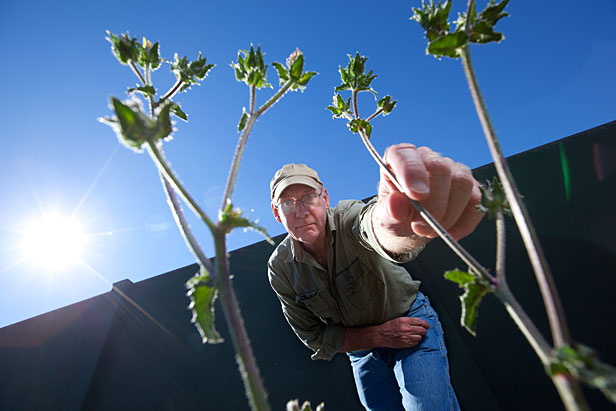 Weed whacker: Fredericks won’t be growing hydroponics’ most famous cash crop, but hopes to vanquish the pest kind by transforming the unkempt parking lots around a Big Green Boxes into community gardens. (Bart Nagel Photography)
Weed whacker: Fredericks won’t be growing hydroponics’ most famous cash crop, but hopes to vanquish the pest kind by transforming the unkempt parking lots around a Big Green Boxes into community gardens. (Bart Nagel Photography)
A. Compared to greenhouses, Big Green Boxes have several advantages. These warehouses are already designed to keep out some of the heat and the cold. That makes it easier for us to control and maintain the optimal temperatures, humidity, and airflow.
Our goal is to be as carbon-neutral as possible. We’ll be using daylighting techniques to capture the sunlight, and we’ll use a lot of LED lighting, which is a bit pricy but is very inexpensive to operate, and pays for itself in energy savings within a year or so. We’ll augment these with other higher-intensity lights to add to the overall color spectrum and provide some desirable heat. To power the growing we’ll use a range of alternate power sources like solar, wind, and other energy-saving techniques.
We plan to use rain catchers for water collection and composting to generate a bit of heat and warmth. We expect that the efficiencies will increase as we learn more about how to be wiser with our energy use and as the solar, wind, and other industrial techniques used in this process progress.
Ten years ago, Big Green Boxes was not economically or technologically feasible. Now it is. And, as the price of the equipment goes down, the price of oil and water go up it becomes more and more desirable. I know we are creating a somewhat artificial growing environment, and I don’t ever expect that we’ll replace outdoor seasonal growing, that’s not our intention. But in the dead of winter and height of summer we can offer an alternative to sending fresh produce on a 1,500-mile pilgrimage from the fields to the table. Which has to be a good thing!
Q. There are several aquaponics startups already in operation, many of them inspired by Will Allen’s Growing Power farm in Milwaukee: Sweet Water Organic, also in Milwaukee, which is up and running; and the startups Cityscape Farms, which Todd Woody wrote about for Grist, and Sky Vegetables, which is building an aquaponics farm on a roof in Massachusetts. Why do you deserve investors’ money more?
A. Well, Sweet Water is a 501(c)3 nonprofit business. We are a for-profit business. As for the others, I think their model of putting greenhouses on rooftops or using vacant lots still leaves them open to all the issues of weather — heating and cooling during harsh hot and cold seasons. I like our business model better; I think we can scale more efficiently and reliably. But I wish them all good fortune since I feel we’re all helping to change the current food chain model — which seems to me to be in need of change, and lots of it.
Q. Why not just take over a defunct mall and grow enough crops for the whole West Coast?
A. I don’t want to feed more than a certain area because I want the greens to be harvested and eaten the same day within a community. And as we’re seeing with the eggs, concentration can be a bad idea. I’d rather build BGB on the hub-and-spoke model in lots of communities.
Q. How far along are you in terms of funding? When can we try some samples?
A. BGB has some seed funding, and we are continuing to raise more. We’ll need a few million dollars by the time we’re at full scale, but we don’t need it all to start. The leafy greens, baby and micro-greens we’ll harvest grow quickly, so we can be generating revenue long before we are at full-scale capacity. We can be up and running with just a few hundred thousand and quickly profitable after we’re at our optimal yield.
We already have a number of people excited about what we can produce, and we plan to create a “taste center” so we can invite our customers — food brokers and their clients — to come and taste a variety of produce on any given day. We have a location picked out for the first BGB, but don’t need the full space yet. Our goal is to start with the taste center, and get more funding to grow out our yield till we are at full scale.
Q. Have you learned any lessons from your previous ventures that have come in handy with Big Green Boxes?
A. It’s all about getting it going. I’ve had to simplify the concept somewhat. But I know sometimes you have to jettison some ideas from the vision in order to have the idea take off. If you’re successful, you can add those visionary parts back in. There will be an educational component from the start, but I hope at some future point we can add more complementary local businesses, create more of a produce mall, and also install raised beds in those big useless parking lots for a community garden. But first we need to be up and running and generating revenue!
Q. To whom do you look for inspiration?
A. A whole lot of people — Ernest Shackleton, Nelson Mandela for their perseverance; Buckminster Fuller and Da Vinci for their ‘out of the box’ ideas; Thomas Jefferson and Ben Franklin for taking on some big, game-changing challenges. My kids inspire me, just because I’m so proud of them.
Q. Company drops by unexpectedly around dinnertime. What do you do?
A. Depends on the company and what’s in the house. If they’re good friends we can always get creative. I lived in New Orleans and it’s amazing what you can put together with very little. Also, living in the Bay Area, we’re really lucky that we have so many options for great local restaurants and food sources. Plus, once we have a BGB nearby, I can get some fresh locally grown produce anytime!
